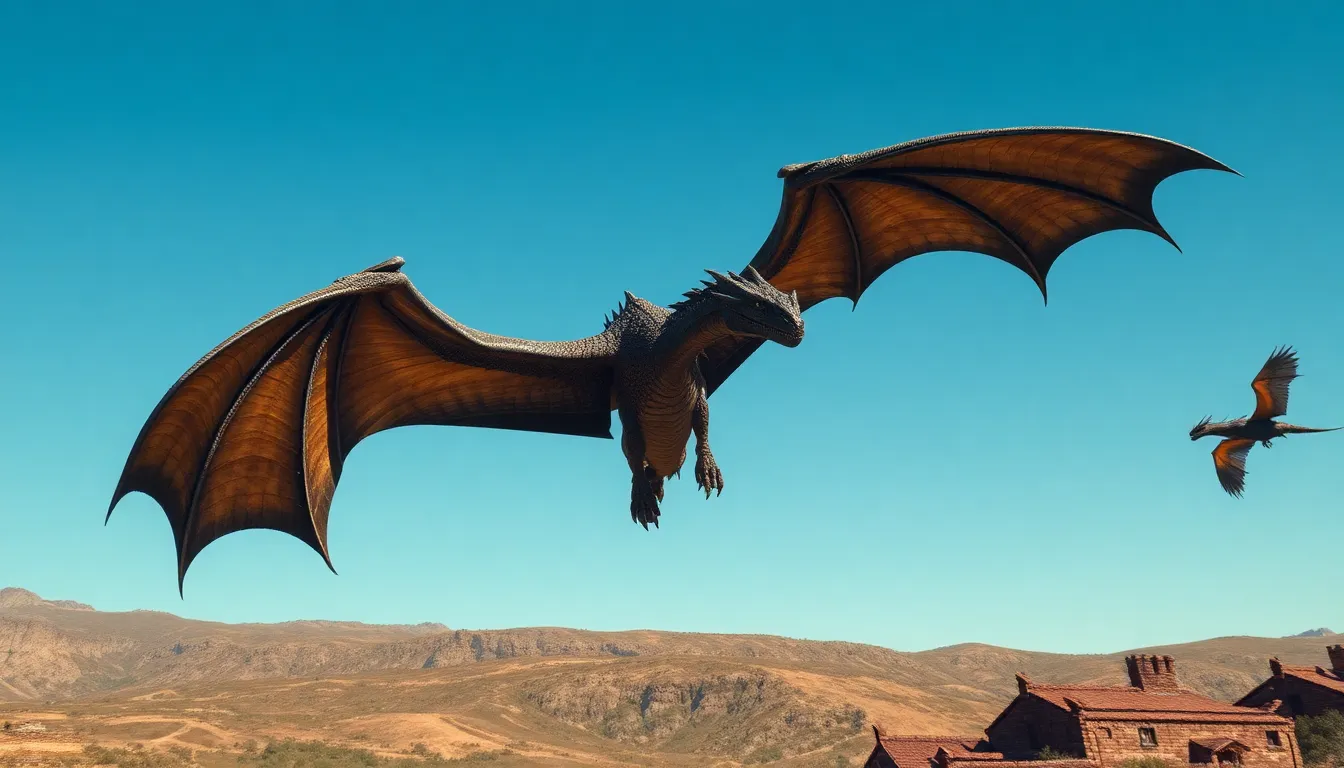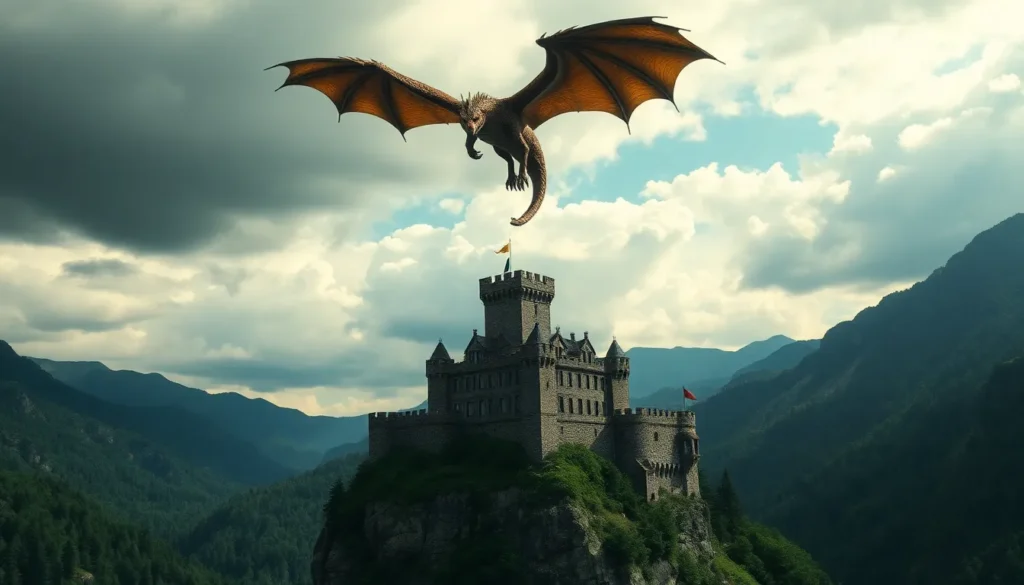Table of Contents
ToggleIn the realm of Westeros, dragons aren’t just massive fire-breathing beasts—they’re the ultimate status symbols. From the pint-sized to the colossal, each dragon in “House of the Dragon” has its own personality, quirks, and, of course, size. Ever wondered how big these legendary creatures really are? Spoiler alert: it’s not just their egos that are inflated!
Overview of Dragon Sizes in House of the Dragon
Dragons in “House of the Dragon” vary significantly in size, reflecting their unique lineage and roles within the Targaryen family. Sizes range from the impressive Vhagar, one of the largest dragons, to smaller creatures like Dreamfyre. Each dragon’s dimensions play a critical role in battles and status among the nobility.
Notably, Vhagar measures approximately 50 feet in length. This colossal dragon exhibits both physical dominance and heightened intelligence, making it a fierce adversary. In contrast, smaller dragons like Syrax reach around 30 feet, showcasing agility and speed in flight.
The growth of these dragons often correlates with the strength of their riders. Younger Targaryens may find their dragons growing quickly, reaching substantial sizes within mere years. Size impacts performance during conflicts, where larger dragons provide tactical advantages and act as symbols of power.
Interestingly, dragon sizes also reflect their unique characteristics. Drogon, while not featured in “House of the Dragon,” displays an imposing stature of about 40 feet, indicating that size can enhance a dragon’s fear factor. Personalities of dragons influence their sizes and the bond with their riders, adding deeper layers to their significance in the storyline.
Statistical comparisons yield insights into their stature over time. Below is a visual representation of notable dragon sizes:
| Dragon | Estimated Length (Feet) | Key Characteristics |
|---|---|---|
| Vhagar | 50 | Size, intelligence, battle prowess |
| Syrax | 30 | Agility, speed, rider affinity |
| Dreamfyre | 25 | Graceful movements, strong loyalty |
| Drogon | 40 | Fear factor, power dynamics |
These sizes resonate with themes of dominance and legacy, amplifying the dragons’ importance in the Targaryen narrative. Each creature embodies a piece of history, showcasing the intricate relationship between size, strength, and the Targaryen legacy.
Major Dragon Species

Dragons in “House of the Dragon” display significant variations in size and personality, correlating with their lineage and roles.
The Great Dragons
Great dragons like Vhagar and Meraxes dominate the skies and represent the pinnacle of Targaryen power. Vhagar measures about 50 feet, showcasing immense physical strength and notable intelligence. Dominance and legacy resonate through these formidable creatures, as they wield power in battle and symbolize status among nobility. Meraxes, another major dragon, also reaches considerable lengths and is feared for its ferocity. Their size is not just impressive, but it directly influences their riders’ capabilities and the broader political landscape of Westeros.
The Smaller Dragons
Smaller dragons serve unique purposes within the Targaryen family. Syrax, for instance, reaches around 30 feet, offering agility and speed in combat scenarios. These dragons often complement their larger counterparts, providing strategic advantages in various conflicts. Smaller species like Dreamfyre play pivotal roles in court dynamics, influencing Targaryen decisions without the overwhelming presence of their larger kin. The size difference highlights the diversity among dragons, showcasing how even the smallest can impact Targaryen legacy and power.
Notable Dragons in the Series
Dragons in “House of the Dragon” showcase remarkable diversity in size and abilities, each reflecting significant aspects of the Targaryen lineage.
Vhagar
Vhagar stands as one of the largest dragons, measuring approximately 50 feet. Known for her sheer power and intelligence, she serves as a strong symbol of Targaryen dominance. Many consider Vhagar to be a crucial asset in battles, attributing her success to both her size and strategic prowess. Riders admire her loyalty and fierce nature, making her a revered figure among dragons. With a storied history spanning generations, Vhagar embodies the might often associated with her name, leaving a lasting impact on the political landscape of Westeros.
Caraxes
Caraxes, often called “The Blood Wyrm,” reaches around 40 feet in length and is renowned for his agility and speed. Recognized for his striking red scales, Caraxes carries a reputation for fearlessness and loyalty to his rider. Many view him as a vital part of the Targaryen military strategy, complementing his rider’s combat abilities. He often engages swiftly in aerial maneuvers, providing both offense and defense on the battlefield. Caraxes’s fierce temperament reflects the passion and ambition of House Targaryen, solidifying his place in the family’s legacy.
Syrax
Syrax, a smaller but equally impactful dragon, measures about 30 feet and is recognized for her agility. Often associated with the strong-willed Rhaenyra Targaryen, she plays a pivotal role in the dynamics of power. Riders appreciate her unique ability to maneuver swiftly in tight spaces, providing tactical advantages during confrontations. Interestingly, her size does not diminish her importance; rather, it enhances her utility in various situations. Syrax symbolizes how even the smaller dragons can significantly influence the Targaryen narrative and showcase the complexities of loyalty and strategy within the family.
Impact of Dragon Sizes on the Storyline
Dragon sizes significantly shape the narrative in “House of the Dragon.” Larger dragons like Vhagar, measuring approximately 50 feet, reflect a formidable presence in battles, bolstering Targaryen power. Their sheer size often intimidates enemy forces, establishing dominance on the battlefield.
Conversely, smaller dragons such as Syrax, which reaches around 30 feet, showcase agility and unique combat strategies. These dragons play crucial roles in tactics, allowing for quick maneuvers that can turn the tide during conflicts. The ability to fly swiftly and dart around opponents aids their riders during critical moments.
Each dragon’s dimension aligns with its rider, influencing their effectiveness and legacy. The strength of a dragon often mirrors its rider’s ambition. For instance, Vhagar’s power directly enhances her rider’s capabilities, exemplifying the connection between size and status within the Targaryen family.
Statistical comparisons of notable dragon sizes emphasize their narrative impact. The diversity of sizes mirrors the complexities of Targaryen relationships and the overarching themes of strength and legacy. Larger dragons command respect, while smaller dragons demonstrate that value lies in individual skills and loyalty.
Highlighting specific dragons illustrates their integral roles. Vhagar’s intelligence and power make her a key player in military strategy, while Caraxes, noted for speed, supports rapid assaults. Even Syrax, though smaller, is crucial to Rhaenyra Targaryen’s storyline, proving that every dragon contributes meaningfully to their family’s legacy.
Overall, dragon sizes and abilities intertwine seamlessly with the interpersonal dynamics within the Targaryens, reinforcing the importance of each dragon’s role in shaping the future of Westeros.
The intricate relationship between dragon sizes and the Targaryen legacy plays a pivotal role in “House of the Dragon.” Each dragon’s unique dimensions not only reflect their lineage but also influence their riders’ ambitions and strategies.
From the formidable Vhagar to the agile Syrax, the diversity among dragons showcases how size impacts power dynamics within Westeros. These legendary creatures are more than mere symbols; they embody the history and aspirations of the Targaryens.
As the series unfolds, the significance of dragon sizes will likely continue to shape the narrative, illustrating the enduring connection between strength, loyalty, and legacy in the world of Westeros.

